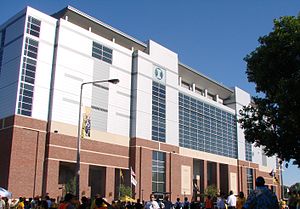Kinnick Stadium
 |
|
| Former names | Iowa Stadium (1929–1972) |
|---|---|
| Location | 886 Stadium Drive Iowa City, Iowa, 52242 |
| Coordinates | 41°39′31″N 91°33′4″W / 41.65861°N 91.55111°WCoordinates: 41°39′31″N 91°33′4″W / 41.65861°N 91.55111°W |
| Owner | University of Iowa |
| Operator | University of Iowa |
| Capacity | 70,585 (2006–present) 70,397 (1992–2005) 70,220 (1990–1991) 67,700 (1983–1989) 60,160 (1956–1982) 53,000 (1929–1955) |
| Surface |
FieldTurf (2009–present) Astroturf (1972–1988) Grass (1929–1971, 1989–2008) |
| Construction | |
| Broke ground | March 6, 1929 |
| Opened | October 5, 1929 |
| Renovated | 2006, 2017-2019 |
| Expanded | 1956, 1983, 1990 |
| Construction cost | $497,151.42 (initial construction) ($6.93 million in 2017 dollars) |
| Architect | Proudfoot, Rawson, and Souers HNTB (renovation) |
| General contractor | Tanger Construction Company |
| Tenants | |
| Iowa Hawkeyes football (NCAA) (1929–present) | |
Kinnick Stadium, formerly known as Iowa Stadium, is a stadium located in Iowa City, Iowa, United States. It is the home stadium of the University of Iowa Hawkeyes, in the sport of college football. First opened in 1929, it currently holds up to 70,585 people, making it the 7th largest stadium in the Big Ten, and one of the 20 largest university owned stadiums in the nation. It is named for Nile Kinnick, the 1939 Heisman Trophy winner and the only Heisman winner in university history, who died in service during World War II. It was named Iowa Stadium until 1972, when longtime lobbying by Cedar Rapids Gazette sportswriter Gus Schrader successfully convinced the UI athletic board to change the name. It is currently the only college football stadium named after a Heisman Trophy winner.
Iowa Stadium was constructed in only seven months between 1928 and 1929. Groundbreaking and construction began on March 6, 1929. Workers worked around the clock using lights by night and horses and mules as the primary heavy-equipment movers. There was a rumor for many years that horses that died during the process were buried under what now is the North end zone. Historians report this is a myth and the animals were disposed of in the nearby Iowa River. The round-the-clock construction came to an end in July. Despite several problems to overcome, including the athletic director's resignation and a slight redesign, the stadium was completed and the first game was played October 5, 1929, against Monmouth College. Iowa won the game 46–0. The stadium was dedicated two weeks later, when the Hawkeyes tied Illinois 7–7.
The playing surface is currently synthetic Field Turf, although it was AstroTurf from 1972 until grass was reinstalled for the 1989 through 2008 seasons. The installation of artificial turf came at the same time that Iowa Stadium was renamed Kinnick Stadium in honor of the Heisman winner who had perished 29 years earlier.
...
Wikipedia
